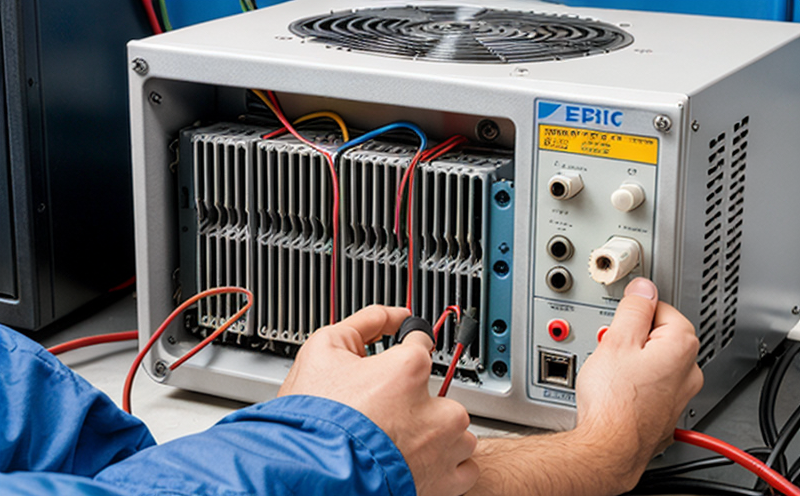IEC 60092-612 Electrical Testing of Shore Connection Systems
The IEC standard 60092-612 is a crucial guideline for the electrical testing of shore connection systems, which are essential components in marine and ship equipment. These systems play a pivotal role in ensuring safe and reliable power transfer between ships and land-based facilities during port visits. The standard provides comprehensive requirements to ensure that these connections meet strict safety and reliability criteria.
The process begins with thorough preparation of the shore connection system, which involves inspecting all electrical components for any visible damage or wear. Following this inspection, a series of tests are conducted to evaluate various parameters such as insulation resistance, voltage drop across conductors, current carrying capacity, and grounding continuity. The testing apparatus used includes high-precision multimeters, insulation testers, and specialized shore connection test rigs that simulate real-world conditions.
The acceptance criteria for IEC 60092-612 are stringent to ensure the highest level of safety and reliability. A specimen must pass all tests with no faults or deviations from specified limits. For instance, insulation resistance should be above a certain threshold value, typically measured in megohms. Voltage drop across conductors is expected to remain within acceptable percentages of nominal values under load conditions.
The importance of this testing cannot be overstated as it directly impacts the safety and efficiency of operations at ports worldwide. By adhering to IEC 60092-612, organizations can ensure compliance with international standards while also enhancing their reputation for quality and reliability among clients and stakeholders. The detailed procedures outlined in the standard provide a clear roadmap for achieving these goals.
The testing process often involves multiple iterations until all requirements are met, which underscores the necessity of experienced personnel who understand both the technical aspects and practical implications of each step. Compliance officers responsible for overseeing such projects benefit greatly from having access to laboratories equipped with state-of-the-art equipment capable of performing precise measurements required by this standard.
In summary, IEC 60092-612 sets forth rigorous requirements that must be adhered to when testing shore connection systems. By following these guidelines meticulously, companies can ensure not only their own compliance but also contribute positively towards maintaining the integrity of maritime infrastructure worldwide.
Scope and Methodology
The scope of IEC 60092-612 covers all aspects related to the electrical testing of shore connection systems used in marine environments. This includes but is not limited to:
- Inspection procedures for identifying potential defects or damages prior to testing.
- Electrical parameter measurements such as insulation resistance, voltage drop across conductors, and current carrying capacity.
- Evaluation of grounding continuity and bonding integrity.
The methodology employed in this testing process follows the principles set forth by IEC 60092-612. It involves several key steps:
- Initial inspection of the shore connection system to identify any visible faults or damages.
- Setting up test rigs that simulate real-world operating conditions for accurate measurement results.
- Performing electrical parameter measurements using appropriate instruments and techniques.
- Evaluating the data obtained against predefined acceptance criteria.
Throughout this process, strict adherence to international standards like IEC 60092-612 ensures consistency and reliability in results. This approach helps maintain high levels of safety and quality across different facilities worldwide.
Quality and Reliability Assurance
Ensuring the quality and reliability of shore connection systems is paramount for maintaining safe and efficient operations at ports globally. To achieve this, several measures are implemented during the testing process:
- Consistent Inspection Procedures: Regular inspections ensure that any potential defects or damages are identified early on, preventing failures later in the system's lifecycle.
- Standardized Test Rigs: Utilizing standardized test rigs allows for consistent and accurate measurement results under controlled conditions.
- Data Analysis: Rigorous analysis of collected data against predefined acceptance criteria guarantees adherence to international standards like IEC 60092-612.
- Continuous Improvement: Feedback from testing processes is used to refine procedures and improve overall performance over time.
The implementation of these measures not only enhances the reliability of shore connection systems but also contributes significantly towards environmental sustainability by minimizing downtime and optimizing resource usage. By adhering strictly to IEC 60092-612, organizations demonstrate their commitment to excellence in quality assurance practices.
Environmental and Sustainability Contributions
The testing of shore connection systems according to IEC 60092-612 goes beyond mere compliance with international standards. It also plays a vital role in promoting environmental sustainability by ensuring the reliability and longevity of these critical components:
- Reduction in Downtime: Reliable shore connection systems reduce unplanned maintenance downtimes, thereby minimizing disruptions to operations.
- Energy Efficiency: By ensuring that connections are efficient, energy losses due to poor performance can be significantly reduced.
- Resource Optimization: Proper testing helps in optimizing the use of resources such as materials and labor throughout the lifecycle of a shore connection system.
Furthermore, adherence to IEC 60092-612 contributes positively towards reducing emissions associated with port operations. Efficient systems lead to lower power consumption, which translates into fewer greenhouse gas emissions. This aligns well with global efforts aimed at combating climate change and promoting sustainable development.
In conclusion, the testing of shore connection systems according to IEC 60092-612 is not just about meeting regulatory requirements but also about fostering a culture of excellence in quality assurance practices that benefits both current and future generations.





